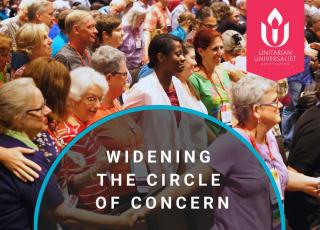Advertisement
What’s really stuck with the Rev. Sally Fritsche are the stories of feeling unwelcome in UU congregations. Specifically, stories from UUs of color. “How common it is for the one Black leader in the church to have his name mixed up with the other prominent Black person in the church,” she said. “Or someone sharing that she was warmly welcomed as a visitor at a church where she’d been going for eight years.”
Fritsche, who is associate minister for congregational life at the UU Church of Urbana-Champaign, Illinois, heard the anecdotes earlier this year while co-leading the welcoming and hospitality session of Widening the Circle of Concern, an eleven-week adult religious education course for five central Illinois UU congregations. The course germinated last year when Terina Carter, who is director of lifespan religious education at the Unitarian Universalist Church of Bloomington-Normal (UUBN), learned about Widening the Circle of Concern,a new UUA study/action guide. Its October release came after the UUA’s Commission on Institutional Change issued its final report last June, following a three-year analysis of structural racism, the workings of power, and white supremacy culture within the UUA.
“We didn’t want the [report] to become something that we talked about on one Sunday and asked people to look at, and then it got set aside,” Carter said. The study/action guide’s sessions, which include theology, living our values in the world, and innovations and risk-taking, offered a way to live into the report.
Moreover, UUBN already wanted to collaborate with other central Illinois congregations, which had also been working on racial justice, said the Rev. Rebecca Gant, minister at UUBN. So when Gant and Carter approached ministers and religious education contacts, respectively, at the Peoria, Springfield, Urbana-Champaign, and Decatur congregations, they all said yes to the course—sparking new connections through a months-long virtual collaboration that is already changing the churches’ work around white supremacy.
About eighty participants met weekly from January until mid-April via Zoom, with staff and leaders from all five congregations helming sessions in tandem. Ahead of each session, participants read a report chapter and reflected on provided questions. Each session included two cycles of breakout groups; the first placed people into random groupings, the second into congregation-specific clusters “so that that group could discuss, ‘What is it in our congregation that we might need to address?’” Gant said. And each week, a designated chaplain was on hand. “It meant a lot to just know [a chaplain was] there; it can be a very vulnerable thing to talk about race and inclusion,” said Fritsche.
Carter and Gant recalled that the session on theology particularly resonated with people. Accountability and resources, one of the last sessions, also did. Participants “could see that the part of ‘let’s do something’ was getting closer,” Gant said.
By the end, each congregation had a custom to-do list. The Urbana-Champaign church has already adopted the Eighth Principle (articulating a commitment to dismantling white supremacy) and added antiracist training to their regular offerings. They’re also planning an external racial justice audit. For her part, Fritsche’s memories of the welcoming and hospitality session have combined with her role as associate minister for congregational life to sharpen her focus. “How can we be up front and explicit as we train people to do welcoming work, as we prepare volunteers?” she wondered. “How can we be really intentional about dealing with bias and racism?”
Additionally, the congregations with racial justice teams are working with churches without them, Gant said. As participants gained insight into white supremacy and the tools for dismantling it, the medium was key to the message, Fritsche said. “If UU congregations keep trying to go it alone, it means we’re asking our members of color to go it alone,” she said. An important message in the Commission on Institutional Change’s report is, “Can you connect people with isolated identities in your congregation to people in other congregations?” she said. “Can you have caucus work?”
In Illinois, where UU congregations can be at least a 30- or 45-minute drive from each other, that communal strength might be particularly novel and needed. For many participants “this was the first time that they’ve been in a space, even an online space, with so many other UUs from the area,” Carter said.
By the end of the course, energized by what they’d learned and their action items, participants knew they wanted to meet again—just thirty days after their last session. “That was too soon,” Carter said, so they’ll meet again this fall to continue widening the circle.
Get the report: The Widening the Circle of Concern report is available for all UUs to read. It is available for purchase as a book, e-book, or for free on uua.org. Visit uua.org/coic-report to get your copy.
Download the Study/Action Guide
Add your congregation to the map of those engaging the Study/Action Guide.
